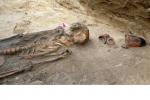Summary (English)
APOLLONIA (Yavor Ivanov – iavor.ivanov@gmail.com, Dimitar Nedev) Twenty-four graves of the 5th century BC were explored. The cemetery was situated on two levels: three urns with ashes were discovered from 80 cm to 1.10 m in depth and the rest of the burials were inhumations situated from 1.60 m to 2.10 m in depth. Greek amphorae and Thracian greyware were used for urns to accommodate the ashes. In a few cases, inhumation burials were discovered on the level of the urns. The grave goods included over 80 vessels: amphoriskoi, amphorae, lekythoi, kantharoi, kylikes, skyphoi, askoi, alabastra, including black-figure and red-figure, and Thracian pottery. Ancient Greeks and Thracians were buried in the cemetery. Part of a water-conduit of terracotta pipes, 3.90 m long, was discovered. The water-conduit dated to the beginning of the 5th century BC. A child was buried over the water-conduit in c. 450 BC. The grave-goods comprised six ceramic vessels, a bronze pin, a bear tooth used as an amulet, over 70 astragaloi, four terracotta figurines: a ram, two seating men and a boy.
- Yavor Ivanov - Archaeological Institute with Museum
- Dimitar Nedev - Archaeological Museum in Sozopol
Director
Team
Research Body
- Archaeological Institute with Museum
- Archaeological Museum in Sozopol






![Download [PDF]](/excavation/skins/fasti/images/results/download_sml.png)